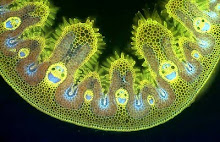Meadow saffron, sometimes known as autumn crocus, also has
the rather salacious name of 'naked ladies' which supposedly stems from its
lack of leaves when the flowers appear in autumn; the leaves sprout in spring and wither away in summer.
The lilac flowers are very attractive to bees.
This is a rare British native wild
plant and most specimens that turn up – like those above, beside a road in Weardale –
are garden escapes. To my mind they perform best when grown in grass
like those in the photograph; when they’re cultivated in bare soil the floral
tubes often grow very long and the flowers fall over in the autumn wind and
rain, but some surrounding grass gives them support.
The plant has a long history of cultivation and in 1776 the
botanist and doctor William Withering, writing in his Botanical Arrangement of all the Vegetables Growing in Great Britain mentioned that ‘cultivation produces a great variety
of colours and makes the blossoms double’.
In the wild meadow saffron was ruthlessly
eliminated because it’s extremely poisonous to grazing livestock, thanks to the
presence of toxic colchicine in all parts of the plant. Like many plant poisons colchicine has been used
medicinally, in very low doses, to treat gout. Benjamin Franklin, himself a
gout sufferer, is supposed to have introduced the plant to the United States for that very purpose.
There have been accidental fatalities with poisoning from either eating
the plant (its leaves resemble very lush wild garlic) or using it as herbal
medicine at lethal concentrations, so one wonders how many of those who followed William Withering’s
advice survived, when he wrote ‘This is one of those plants that upon the
concurrent testimony of ages was condemned as poisonous; but Dr. Storck of
Vienna hath taught us that it is a useful medicine. The roots have a good deal
of acrimony. An infusion of them in vinegar, formed into a syrop by the
addition of sugar or honey, is found to be a very useful pectoral and diuretic.
It seems in its virtues very much to resemble squill, but it is less nauseous
and less acrimonious’.
Colchicine is used by plant breeders to double the number of
chromosomes in plants, because the drug allows the chromosomes to divide
without the cell they are in dividing, so doubling the number of chromosomes in
the cell - a phenomenon known as polyploidy. More chromosomes per cell tend to
produce larger cells and larger cells lead to larger plants and better crops.
All sorts of unnaturally large plants, ranging from strawberries
to hyacinths, have been bred using this long-standing form of genetic
manipulation, which has been in use for over a century. Crossing a colchicine-induced tetraploid, which has double the normal chromosone complement, with a diploid plant that has the normal complement of chromosomes produces plants called
triploids, with three sets of chromosomes per cell, which are seed- sterile – a
common breeding technique for producing seedless fruit such as bananas.























